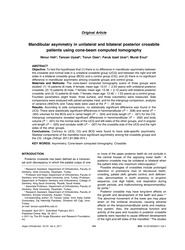Mandibular asymmetry in unilateral and bilateral posterior crossbite patients using cone-beam computed tomography
-
Eser Sahibi
İLKNUR VELİ
-
Görnüş
Makale
- Neşir senesi 2011
-
Publisher
The E. H. Angle Education and Research Foundation
- Iňleýin Görnüşli Salgysy Http://hdl.handle.net/11469/152
-
Konu Başlıkları
Asymmetry
Cone-beam computed tomography
Crossbite
Objective: To test the hypotheses that (1) there is no difference in mandibular asymmetry between
the crossbite and normal side in a unilateral crossbite group (UCG) and between the right and left
sides in a bilateral crossbite group (BCG) and a control group (CG); and (2) there is no significant
difference in mandibular asymmetry among crossbite groups and control group.
Materials and Methods: The cone-beam computed tomography scans of three groups were
studied: (1) 15 patients (6 male, 9 female; mean age: 13.51 6 2.03 years) with unilateral posterior
crossbite; (2) 15 patients (8 male, 7 female; mean age: 13.36 6 2.12 years) with bilateral posterior
crossbite; and (3) 15 patients (8 male, 7 female; mean age: 13.46 6 1.53 years) as a control group.
Fourteen parameters (eight linear, three surface, and three volumetric) were measured. Side
comparisons were analyzed with paired samples t-test, and for the intergroup comparison, analysis
of variance (ANOVA) and Tukey tests were used at the P , .05 level.
Results: According to side comparisons, no statistically significant difference was found in the
UCG. There were statistically significant differences in hemimandibular (P 5 .008) and ramal (P 5
.004) volumes for the BCG and in ramal height (P 5 .024) and body length (P 5 .021) for the CG.
Intergroup comparisons revealed significant differences in hemimandibular (P 5 .002) and body
volume (P , .001) for the normal side of the UCG and left sides of the other groups, and in angular
unit length (P 5 .025) and condylar width (P 5 .007) for the crossbite side of the UCG and the right
sides of the other groups.
Conclusions: Contrary to UCG, CG and BCG were found to have side-specific asymmetry.
Skeletal components of the mandible have significant asymmetry among the crossbite groups and
the CG.
-
Koleksiyonlar
FAKÜLTELER
DİŞ HEKİMLİĞİ FAKÜLTESİ
KLİNİK BİLİMLER BÖLÜMÜ

 Tam Metin
Tam Metin

